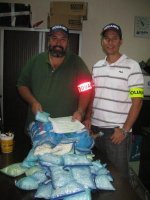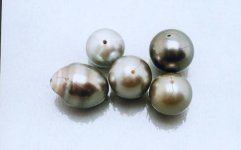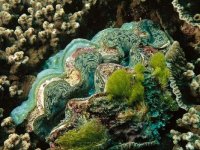Cyril Roger Brossard
Well-known member
- Joined
- Aug 30, 2012
- Messages
- 408
as seen here.
"Une nouvelle saisie de 108 kg de nuclei prohib?s, destin?s ? greffer les hu?tres perli?res a
?t? effectu?e par le bureau de douane du port de Papeete.
Il s’agit de la cinqui?me saisie de ce type r?alis?e au cours des six derniers mois, qui porte ? 543 kg le poids total de nuclei prohib?s intercept?s ? l’importation. Le contr?le de qualit? des nuclei import?s est essentiel pour la prosp?rit? et l’avenir du secteur perlicole en Polyn?sie fran?aise.
Les nuclei en b?nitier produisent des perles qui perdent toute valeur marchande car elles ne peuvent ?tre travaill?es (Voir photo ci dessous).

C’est pourquoi l’utilisation de nuclei en b?nitier est strictement interdite par l’arr?t? 1240/CM du 30/08/07 relatif ? la qualit? des nuclei import?s, commercialis?s et autoris?s ? la greffe.
Les cinq saisies r?centes portent sur quelque 435 000 nuclei prohib?s qui auraient permis la production d’autant de perles, toutes impropres ? la commercialisation. Leur mise sur le
march? international aurait ruin? la r?putation de la perle de Tahiti.
Compte tenu de l’enjeu ?conomique consid?rable et ? la demande du ministre des ressources marines, la douane a renforc? ses contr?les sur les produits de la perliculture – nuclei import?s, perles circulant ? l’int?rieur de la Polyn?sie et exportation de perles – afin de prot?ger le label “Perle de Tahiti”.
Une coop?ration active et fructueuse a ?t? mise en place entre la douane et la direction des ressources marines. Les services douaniers de contr?le disposent aujourd’hui d’un appareil sophistiqu?, de haute technologie, qui permet de contr?ler la mati?re constitutive des nuclei import?s. Aujourd’hui, les importations de nuclei, r?alis?es principalement par la voie a?rienne notamment en fret express, peuvent ?tre soumises ? un contr?le approfondi.
Contr?ler les marchandises import?es ou export?es est le coeur de la mission de la douane. Faire respecter les prohibitions qui frappent certains produits constitue une priorit? absolue. Ces importantes et r?currentes saisies de produits prohib?s illustrent la mission de protection exerc?e par la douane.
Au cas particulier, elle l’a rempli dans deux domaines :
- ?conomique, en faisant obstacle ? une pratique pr?judiciable ? la fili?re perlicole, qui demeure l’un des piliers de la production et de l’exportation de la Polyn?sie fran?aise ;
- environnemental, en saisissant les produits d’une esp?ce menac?e d’extinction ? l’?chelle mondiale par un commerce international non r?gul?. Les b?nitiers sont en effet, prot?g?s par la Convention de Washington."
Google translate:
A new seizure of 108 kg of nuclei prohibited for grafted pearl oysters has been carried out by the customs office of the port of Papeete.
This is the fifth entry of its kind in the past six months, bringing the total weight of 543 kg of intercepted nuclei (prohibited import). The quality control of imported nuclei is essential for the prosperity and future of the pearl industry in French Polynesia.
The tridacna nuclei produce pearls losing any value because they can not be worked (see photo below).

This is why the use of tridacna nuclei is strictly forbidden by the decree of 30/08/07 1240/CM on the quality of the nuclei imported, marketed and licensed to transplantation.
The five recent seizures involve some 435,000 nuclei that would have produced as many pearls, all unmarketable. Placing on the international market would have ruined the reputation of the pearl.
Given the considerable economic stake and at the request of the Minister of Marine Resources, Customs has strengthened its controls on products of pearl - nuclei imported beads flowing within Polynesia and export beads - to protect the label "Tahitian Pearl".
An active and fruitful cooperation has been established between Customs and the management of marine resources. Customs control now have a sophisticated, high technology, which allows you to control the material constituting the nuclei imported. Today, imports of nuclei, carried out mainly by air including express freight, may be subject to a thorough inspection.
Checking the imported or exported goods is the heart of the mission of customs. Enforcing prohibitions affecting certain products is a priority. These important and recurrent seizures of prohibited illustrate the mission of protection by customs.
In this particular case, it was completed in two areas:
- Economic, hindering a practice detrimental to the pearl industry, which remains one of the pillars of the production and export of French Polynesia;
- Environmental, seizing the products of endangered species worldwide by unregulated international trade. Clams are indeed protected by the Washington Convention.
"Une nouvelle saisie de 108 kg de nuclei prohib?s, destin?s ? greffer les hu?tres perli?res a
?t? effectu?e par le bureau de douane du port de Papeete.
Il s’agit de la cinqui?me saisie de ce type r?alis?e au cours des six derniers mois, qui porte ? 543 kg le poids total de nuclei prohib?s intercept?s ? l’importation. Le contr?le de qualit? des nuclei import?s est essentiel pour la prosp?rit? et l’avenir du secteur perlicole en Polyn?sie fran?aise.
Les nuclei en b?nitier produisent des perles qui perdent toute valeur marchande car elles ne peuvent ?tre travaill?es (Voir photo ci dessous).

C’est pourquoi l’utilisation de nuclei en b?nitier est strictement interdite par l’arr?t? 1240/CM du 30/08/07 relatif ? la qualit? des nuclei import?s, commercialis?s et autoris?s ? la greffe.
Les cinq saisies r?centes portent sur quelque 435 000 nuclei prohib?s qui auraient permis la production d’autant de perles, toutes impropres ? la commercialisation. Leur mise sur le
march? international aurait ruin? la r?putation de la perle de Tahiti.
Compte tenu de l’enjeu ?conomique consid?rable et ? la demande du ministre des ressources marines, la douane a renforc? ses contr?les sur les produits de la perliculture – nuclei import?s, perles circulant ? l’int?rieur de la Polyn?sie et exportation de perles – afin de prot?ger le label “Perle de Tahiti”.
Une coop?ration active et fructueuse a ?t? mise en place entre la douane et la direction des ressources marines. Les services douaniers de contr?le disposent aujourd’hui d’un appareil sophistiqu?, de haute technologie, qui permet de contr?ler la mati?re constitutive des nuclei import?s. Aujourd’hui, les importations de nuclei, r?alis?es principalement par la voie a?rienne notamment en fret express, peuvent ?tre soumises ? un contr?le approfondi.
Contr?ler les marchandises import?es ou export?es est le coeur de la mission de la douane. Faire respecter les prohibitions qui frappent certains produits constitue une priorit? absolue. Ces importantes et r?currentes saisies de produits prohib?s illustrent la mission de protection exerc?e par la douane.
Au cas particulier, elle l’a rempli dans deux domaines :
- ?conomique, en faisant obstacle ? une pratique pr?judiciable ? la fili?re perlicole, qui demeure l’un des piliers de la production et de l’exportation de la Polyn?sie fran?aise ;
- environnemental, en saisissant les produits d’une esp?ce menac?e d’extinction ? l’?chelle mondiale par un commerce international non r?gul?. Les b?nitiers sont en effet, prot?g?s par la Convention de Washington."
Google translate:
A new seizure of 108 kg of nuclei prohibited for grafted pearl oysters has been carried out by the customs office of the port of Papeete.
This is the fifth entry of its kind in the past six months, bringing the total weight of 543 kg of intercepted nuclei (prohibited import). The quality control of imported nuclei is essential for the prosperity and future of the pearl industry in French Polynesia.
The tridacna nuclei produce pearls losing any value because they can not be worked (see photo below).

This is why the use of tridacna nuclei is strictly forbidden by the decree of 30/08/07 1240/CM on the quality of the nuclei imported, marketed and licensed to transplantation.
The five recent seizures involve some 435,000 nuclei that would have produced as many pearls, all unmarketable. Placing on the international market would have ruined the reputation of the pearl.
Given the considerable economic stake and at the request of the Minister of Marine Resources, Customs has strengthened its controls on products of pearl - nuclei imported beads flowing within Polynesia and export beads - to protect the label "Tahitian Pearl".
An active and fruitful cooperation has been established between Customs and the management of marine resources. Customs control now have a sophisticated, high technology, which allows you to control the material constituting the nuclei imported. Today, imports of nuclei, carried out mainly by air including express freight, may be subject to a thorough inspection.
Checking the imported or exported goods is the heart of the mission of customs. Enforcing prohibitions affecting certain products is a priority. These important and recurrent seizures of prohibited illustrate the mission of protection by customs.
In this particular case, it was completed in two areas:
- Economic, hindering a practice detrimental to the pearl industry, which remains one of the pillars of the production and export of French Polynesia;
- Environmental, seizing the products of endangered species worldwide by unregulated international trade. Clams are indeed protected by the Washington Convention.

